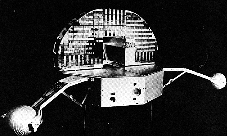
The first in a series of 8 successfully launched Orbiting Solar
Observatories (OSO 1) was launched on 7 March 1962. The 200 kg spacecraft
had a 9-sided spinning wheel section 1.2 m in diameter joined onto a fan-
shaped sail section. It was put into a roughly circular orbit at ~ 575 km
altitude, 32.8 degrees inclination. It s primary mission objectives were to
measure the solar electromagnetic radiation in the UV, X-ray, and gamma-ray
regions. Secondarily, it was to investigate dust particle in space. Data
transmission ended on 6 August 1963. The satellite reentered the
Earth's atmosphere 8 October 1981.
There were a number of X-ray and gamma-ray experiments aboard OSO 1 for
performing solar observations. One instrument, however, the University of
Minnesota Gamma-ray Experiment, was designed to provide preliminary
measurements of the intensity and directional properties of low-energy
gamma-rays in space. The detector operated in the 50 keV - 3 MeV range. For
the 50-150 keV range, a NaI(Tl) scintillation crystal monitored radiation
through a lead shield. The detector operating in the 0.3-1.0 MeV and
1.0-3.0 MeV energy regions used two scintillators connected as a Compton
coincidence telescope.
The U. Minnesota gamma-ray experiment on OSO 1 produced a measurement of
the extraterrestrial gamma-ray flux between 0.5-3.0 MeV, and an indication
of its origin on the celestial sphere. Equally important, this experiment
began to define the background problems encountered in gamma-ray astronomy.